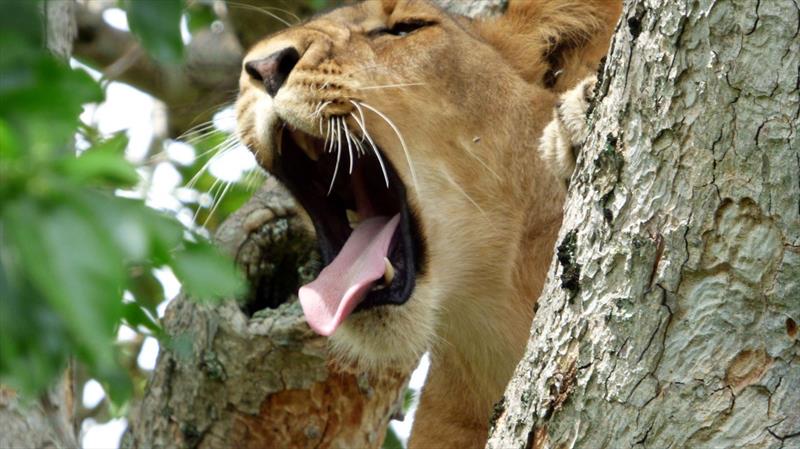Queen Elizabeth National Park – The Medley of Wonders
The 1’978sq.km park is Uganda’s second largest national park enjoying a spectacular view of the Rwenzori Mountains, towering in the backdrop. The park was named after Queen Elizabeth II to commemorate her visit in 1952, changing its name from the initial Kazinga national park in 1952. The park enjoys a warm location in the western tourism circuit close to the Semlliki, and Kibale Forest national parks.
Queen Elizabeth national park is located in the Rift Valley area, situated at the foot of the Rwenzori, the “Mountains of the Moon” fringed by lakes Edward and George. The beautiful plains and blend of habitats of the park take in a countless number of crater lakes, fresh water bodies and marshes, forest fringed zones and open savanna areas.
While on a boat safari along the 32km Kazinga channel waterway, your eyes will set into the Mweya Peninsular. Queen Elizabeth’s diverse ecosystem supports an assortment of wildlife with over 90 mammal species including 4 of the African Big Five and 600 bird species, a tally that makes it Africa’s protected area with the highest number.
The Queen Elizabeth conservation area takes in the wildlife reserves of Kigezi in the southern sector and Kyambura in the Northeast as well as Maramagambo and Kalinzu Forests. These reserves are known for their concentration of forest species like primates, and birds.
South of the park is the Ishasha sector known for its tree climbing Lions and variety of savanna bird species. This sector is a prime spot for de-tours to Bwindi Impenetrable Forest.

How to get to the park
There are two possible routes from Kampala to reach the park; the first and shortest route through Mbarara and Bushenyi takes about 6-7hours. Visitors through this route enjoy detours to the Equator and Igongo cultural center. Visitors from the parks of Mgahinga, Bwindi can also reach the park through the southern section of Ishasha.
The second route leads from north of the park along the Kampala-Fort Portal highway to Kasese taking roughly 7-8 hours to the center of the park. This route offers scenic views into the Rwenzori Mountain and visitors may have an option of taking on overnight detours to Kibale forest national park.
Alternatively, the park can be accessed using a domestic flight from Entebbe, either Charter or Scheduled to existing airstrips of Kasese, Mweya or Ishasha rewarding one with scenic views of Uganda from above.
Wildlife in the park
Queen Elizabeth National Park is an alluring destination for its diversity in both flora and fauna as well as its beautiful scenery. A checklist of more than 600 bird species makes Queen Elizabeth classified as an Important Birding Area (IBA) by Birding International and this figure is the highest of any East African National Park as well making it nearly a quarter of Africa’s total bird population. The park is transitional to the Central African forests and the East African savannas making it ideal to spot both the East and Central African species. Its bird list is only outshined by the far larger Virunga National Park in Congo Democratic Republic and this therefore makes Queen have a phenomenal number for such a smaller area.
Among its impressive species are; the Greater and Lesser Flamingos in Kyambura Wildlife reserve, Martial Eagles, Papyrus Canary, African Skimmer, Papyrus Gonolek, Corncrake, White-winged Warbler, Black-rumped Buttonquail, African Paradise Flycatcher, Shoebill Stork, and Crowned Hornbill among others.
The park has a diverse eco-system composed of open and forest savanna patches, craters and fresh water lakes, fertile wetlands and humid forests making it a classic habitat for variety of wildlife species like mammals and birds. The park’s forest ecosystem with other sites like Maramagambo make it an ideal residence for variety of forest species.
The Kazinga channel waterway; a stretch between Lakes Edward and George is a prime spot for schools Hippopotamuses and a number of water species.
What to do in Queen Elizabeth national park
Visitors to Queen Elizabeth National Park have chance to take part in fascinating safari activities and being rewarded with great African safari memories. Trails through the forested depths of Kyambura Gorge and Kalinzu Forest Reserve (near the park) reward tourists with epic Chimpanzee tracking encounters and sights of many other primate species.
Game tracks through Kasenyi Plains, North Kazinga plains or the Mweya Peninsular and the Ishasha sector (famous for its resident tree climbing lions) offer classic African Game drives for wildlife viewing. The Kazinga Channel waterway is an epitome of enthralling launch cruises; regarded as the most relaxing way to enjoy an African safari.
For those seeking active safari experiences, Nature treks are one of the ways to explore the park’s landscapes and wildlife; this can be done at locations such as Maramagambo forest, Kyambura gorge, Mweya peninsular and Ishasha River where one can see variety of savanna and forest species as well as getting up-close to Hippopotamuses on foot.
Wildlife research and Experiential tours allow visitors great time to learn more about Africa’s fauna, this activity lets visitors actively participate in monitoring some of the exotic birds and mammals within the park using locator devices and also learn habituation calls among others. Experiential activities like Mongoose tracking, Lion or predator tracking and Hippo census are an interesting African wildlife encounter.
The endless list of activities like Cultural heritage trail, and Bird watching safaris make your safari to the park memorable.
